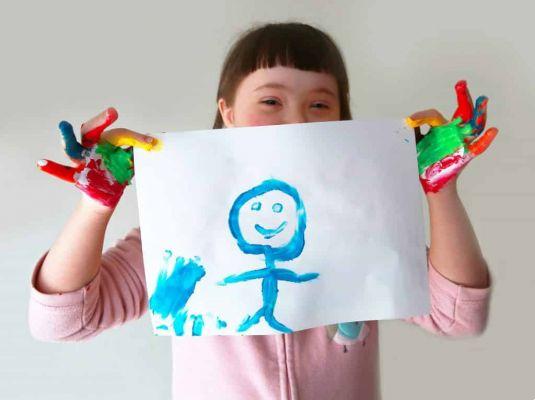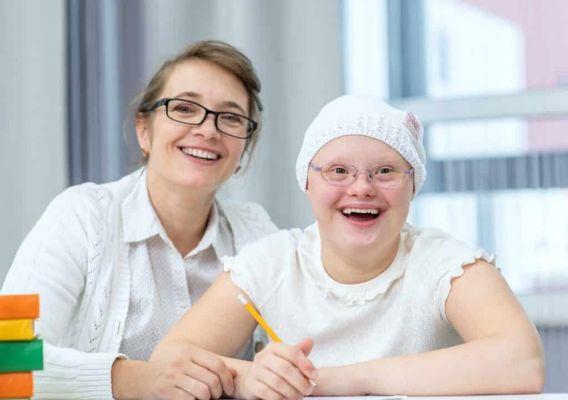Down syndrome is a genetic alteration resulting from an error in the process of cell division, when a fetus is developing inside the mother's body. In this case, instead of this new person having two chromosomes in the 21st pair, he will have three.
What seems like an irrelevant change in cellular organization, however, can manifest in this person as slanted eyes, proportionately smaller hands than others, rounded face, motor difficulties, heart problems, short stature, tendency to diseases such as hypothyroidism and diabetes. , increased risk of infections and intellectual impairment.
Although it is not possible to redo cell division, it is important that the person who has Down syndrome is followed up by doctors throughout his life, to prevent the health problems mentioned above from developing. It is important to note that Down syndrome is not a disease and should not be treated as something to be cured.
After learning a little more about what Down syndrome is and how it can affect a person, let's reflect on how the inclusion of children with Down syndrome in schools should work. Delve into the topic and expand your knowledge!
How does Down syndrome affect learning?
When talking about schools and Down syndrome, we must remember that this genetic alteration causes intellectual impairment, manifested by the delay in speech articulation, for example. Does this mean that children who have the syndrome will never learn and that they should not attend schools? No!

A person who has Down syndrome has a different learning profile than a person who does not have it, and schools must adapt to this. This learning profile must be understood so that education can be inclusive for all people. Next, learn more about it!
To understand the learning profile of a child who has Down syndrome, let's look at what facilitates the learning process. From this, we will know which strategies schools, teachers and families can apply in teaching. Check out!
Facilitators of the learning process
Down syndrome makes it easier for a person to learn from images and gestures. So she is likely to copy other people's movements and attitudes, use signs and gestures and be able to perform practical exercises when learning something.
It is important to note, however, that the child in question does not suffer from a visual impairment, which can happen when there is such a genetic change. The signs of this are watery eyes, pupil tremor, hesitant gait and approaching objects to the face, for example. In this case, you should place the child in the first chairs, hand in printed texts in larger and colorful letters and use dark colored pens when writing.
If the child has a hearing impairment, it is also possible to make small changes to better serve them. Talking directly to the child, highlighting the beginning and end of the sentence, using gestures and signs and repeating sentences or words are ways to ensure that everything will be heard and understood.
As motor skills can be impaired with the syndrome, it is necessary to develop activities that work the muscles of the body, such as opening and closing the hands, writing on an inclined surface, betting on exercises that promote hand-eye coordination, working on painting. with your fingers and hold a pencil correctly.

Difficulties with speech and language will need patience to be alleviated. It is necessary to listen carefully to what the child says, give them time to understand the instructions given, avoid ambiguous vocabulary, reinforce sentences with printed images and use objects to represent ideas.
Another point to be noted is that the period for which the child will be concentrated may be shorter than expected. In this case, just vary the activities frequently, set intervals between each activity and choose tasks of short duration.
By following these methods, ensuring that the child is feeling comfortable and talking to them often, it is possible to prevent them from acting inappropriately, as they will know that they are being welcomed and cared for.
Difference between include and integrate
Schools can and should take simple steps to ensure that children with Down syndrome are included in the learning process. As we saw earlier, these are changes in the way of teaching that will not harm other students, and that can be applied by good professionals.
In this sense, it is essential to understand the difference between including and integrating. When a child with Down syndrome is integrated into a school, it is assumed that this institution does not develop new ways of teaching and meeting this different demand. It is as if the child had the same learning conditions as the others.
On the other hand, to include is to adopt methods that include the child in the educational process, making it reach the same level as all others, in terms of learning. Inclusive education is the way to combat prejudice and discrimination that these children may suffer throughout their lives.
The importance of welcoming
According to the 2010 Census, about 1 in 700 births have Down syndrome. This means that, at that time, approximately 270 Spanish people had this genetic alteration. However, 2019 Down Movement data shows that only 74 people with Down syndrome are or have graduated from Higher Education.

The data presented prove that there is still a long way to go for people with Down syndrome to have the opportunity to develop their own skills, be present in educational institutions and be able to live in a world adapted to them. Combating ableism is essential for society to stop seeing these people as incapable of joining any educational institutions.
You may also like
- Learn how hippotherapy can help those with Down syndrome
- Learn from the story of a family who discovered a new world
- Understand the need for speech therapy in Down syndrome
People with Down syndrome do not need to adapt to schools. It is schools that must adapt to their needs, with different, attractive teaching methods that allow children to develop skills that can still be taught. The effort to promote the inclusion of these people in schools and communities as a whole must be collective.

























